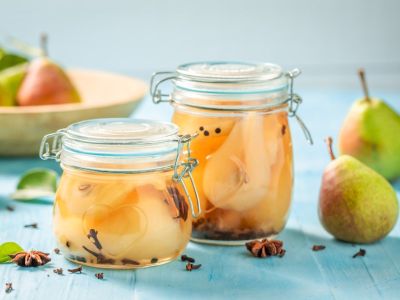About Harvesting Pears
There’s nothing like a pear eaten fresh at its peak, but it isn’t always possible or easy to tell when a pear is ready. Pears ripen from the inside out, so if a pear is allowed to ripen on the tree you may end up with fruit that looks good on the outside but is soft and brown on the interior. This means that pears are usually harvested when they are still firm/hard and then ripened off the tree. Pears can be ripened in a couple of ways. If they are going to be eaten soon, ripen them at room temperature on the kitchen counter. If you want to hasten ripening, place pears in a sealed paper bag. The fruit gives off ethylene gas which then accumulates in the bag which speeds up the ripening. For long term storage of pears, store the fruit for 1-3 months in the refrigerator. When you are ready to use them, remove pears from refrigeration and allow ripening as above.
Preserving Pears by Canning
Some types of pears are more suited to canning than others. These include Green and Red Anjou, Red Bartlett, Concorde, Kieffer, and Seckel. Pears can be canned using either a hot pack or raw pack method. The basic difference in these two methods is that in the hot pack method the pears are heated along with the syrup, whereas with the raw pack method the pears are placed fresh in the jar and hot syrup is poured over them before sealing. It takes 2-3 pounds of fruit to fill a quart (a bit less than a liter) jar, or about 50 pounds (23 kg) to yield 20-25 quart jars.
Getting Started
Wash the pears, peel, core and cut into halves. To keep the fruit from browning place the cut fruit in either a mix of ascorbic acid and water or a crushed vitamin C tablet dissolved in water. Drain the fruit from this mixture prior to heating or packing raw. Once the fruit is in the jars with the lids on, process the jars in a boiling (212 F or 100 C) water canner; hot pack for 25 minutes and raw pack for 30 minutes. Allow to sit for 5 minutes off the burner before removing from the water canner.
Other Ways to Preserve Pears
Pears can also be made into pickles or delicious chutneys. They can be dried into fruit leathers or fruit rolls. In this preservation method, note that pears alone yield a rather grainy and tasteless product so it is better to combine the fruit with other fruit such as berries, peaches, plums or apricots. Pears can be dried either in a dehydrator, an oven or in the sun. In this case use firm, ripe pears rather than those that are going soft. Also peel the fruit prior to drying otherwise the dried peel gets unpleasantly hard. Again, before drying to prevent brown fruit, soak in a mix of ascorbic acid or crushed vitamin C and water. Lastly, pears can be preserved as butters or preserves. Pear butter is delicious spiced with nutmeg, cinnamon, orange peel or juice and a hint of ginger. Cook pear butter in the microwave, slow cooker or oven. If you’re not planning to eat the pear butter immediately, fill sterile jars with the hot butter and process for 5 minutes in boiling water. Remove from heat and let sit for an additional five minutes before removing from the water canner.
